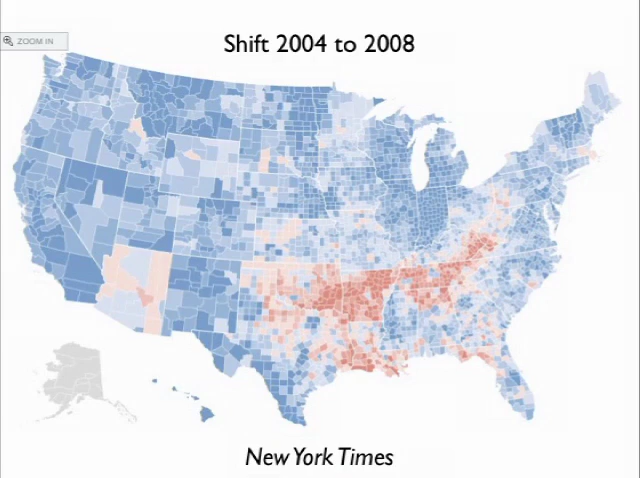note there's a zone going from south-western Pennsylvania through West Virginia, particularly in the coal mining areas
看這個(紅色)區(qū)域 從賓夕法尼亞西南部 延伸到西弗吉尼亞地區(qū) 尤其是煤礦產(chǎn)區(qū)
this is the traditionally Democratic voting part of West Virginia
過去這里一向是西弗吉尼亞傾向民主黨的地區(qū)
that's where you see the biggest shift
如今卻大幅地轉向支持共和黨
the coal mining counties of Kentucky
還有肯塔基州的產(chǎn)煤縣
almost all of Tennessee, northern Alabama, virtually the entire state of Arkansas
幾乎整個田納西州 阿拉巴馬州西部 以及幾乎整個阿肯色州(都泛紅)
although it's interesting
有趣的是
the Wal-Mart headquarters area up here stayed the same
沃爾瑪總部所在地的支持率幾乎保持不變
these south-eastern counties of Oklahoma, this was the Democratic part of the state
俄克拉荷馬東南部的縣曾是民主黨的支持區(qū)域
recently as 1988 Dukakis won all those counties
1988年杜卡基斯在此大獲全勝
and now they have all shifted in the Republican direction
然而現(xiàn)在他們都轉而向共和黨靠攏

seems like Dukakis was hardly the kind of candidate who had appealed to people
作為總統(tǒng)候選人 杜卡基斯 對于俄克拉荷馬東南部的選民 不像是一個很具吸引力的選擇
but he had more appeal than Barack Obama
但他的確比奧巴馬吸引了更多選票
that we can pretty much categorically say
我想這是毫無疑問的
ok it's a question about having to do with the the fact that the switch of more affluent highly educated voters to the Democratic Party has certain economic rationale
他的問題是關于高學歷高收入選民更多地傾向民主黨 與經(jīng)濟因素有關
certainly in a lot of counties with high foreclosure rate places like San Joaquin County, we see a real strong blue shift
在一些止贖率較高的縣 如圣華金縣 大幅度轉向民主黨
we certainly see that
很明顯
well Charlotte North Carolina would be an interesting case
還有北卡的夏洛特也是個有趣的例子
that's now the second largest financial center in the country after New York
它現(xiàn)在已成為全美第二大金融中心 僅次于紐約
and it has a very major blue shift here
該地區(qū)也大比例向藍營靠攏
yeah if you look at really economically distressed areas like western Pennsylvania
當然如果我們反觀一些正在遭受經(jīng)濟衰落的地區(qū) 如賓夕法尼亞西部
centers of heavy industry there you don't see it
過去的重工業(yè)中心 則沒有這種趨勢
there if anything you see a little bit of a red shift
甚至會看到向紅營偏轉的趨勢
so we got to look at the cultural factors and economic factors
所以我們發(fā)現(xiàn)文化因素和經(jīng)濟因素
all these things are coming into play
的確都對選情起著一定影響
yeah I'm always X of giving explanations
所以我不能對數(shù)據(jù)進行詳細的解釋
all I can really do is point out map correlations
我能做的只是分析圖中的各種聯(lián)系
I'll leave it to statisticians
我想處理數(shù)據(jù)是統(tǒng)計學家的工作
who can run their regression analyses to give us harder numbers on those sort of things
他們通過回歸分析等工具為我們提供更精準的數(shù)據(jù)
well that's interesting
很有趣的問題
the question is this the most fundamentalist?
紅色區(qū)域是否聚集了大部分正統(tǒng)基督信徒
it is... one thing we can say that is an area with very high percentage of Southern Baptist and low percentage of African Americans
某個程度上 的確在這個地區(qū) 美南浸信教徒的比例很高 而且黑人的比例很低
it's the northern edge of that Southern Baptist zone
是美南浸信會北部的邊緣地帶
although again Virginia and North Carolina are exceptions
弗吉尼亞和北卡在這兒是例外
so it's the interior southern Baptist without any African Americans
美南浸信會信區(qū)的中間地帶則幾乎沒有任何黑人
that's more than anything else that what it shows
這些細節(jié)圖中沒法看出來
Louisiana is somewhat interesting
路易安娜的情況很有趣
it has a very high percentage of African Americans
那里黑人居民的比例很高
although if we have time I'll show you a map of Louisiana
如果我們時間充裕 我會給你們看一幅路易安娜的地圖
it's a good correlation of the counties with low African American populations doing much more of this red shift
你們會看見黑人人口越少的縣 越傾向于轉向支持共和黨
plus a lot of African Americans left Louisiana after Katrina haven't come back
而且很多因卡特琳娜颶風而迫離 路易安娜州的黑人都沒再回來
so that's something to note
這也許導致了他們像紅偏轉
we can look at some, give more detail when you look at some of the state maps
我們以后看單個州的地圖時會講到更多細節(jié)











